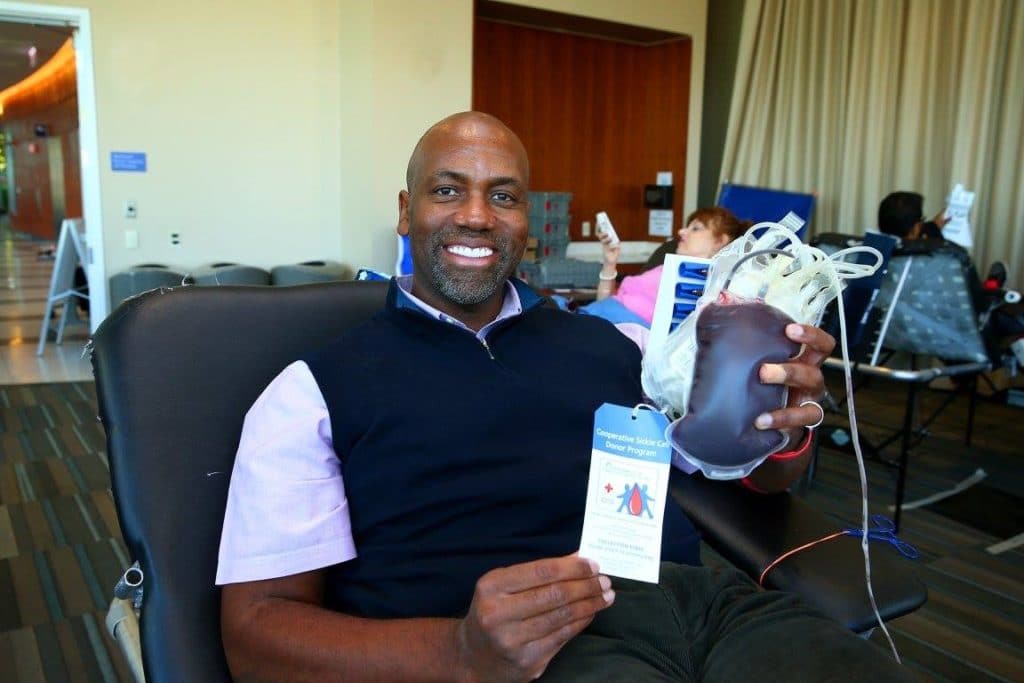September is Sickle Cell Awareness Month and Childhood Cancer Awareness Month. Many of us, (myself included) have changed our profile pictures to include frames and filters on various social media platforms this month that draw attention to sickle cell and childhood cancers. We can do one more thing – donate blood to help those battling these illnesses.
I was not a routine blood donor until well into adulthood. I didn’t understand what the need was or how important it was to donate blood. When I came to my current job as a physician who takes care of patients with blood disorders, I started a program where we go out into the community to recruit African American blood donors to help patients with sickle cell disease because there is a need. According to the American Red Cross, only three percent of the U.S. population donates blood and only a small fraction of those are of African descent.
Correcting Historical Hesitation Through Advocacy and Awareness
There are likely some historical reasons why people of color may be reluctant to donate blood. People who have the same blood type can be donors for each other, regardless of race. However, for patients who need blood frequently there is an even better option. We all have minor proteins in our red cells, which are more likely to be the same from people of a similar ethnicity. Because most donors are Caucasian, and the great majority of patients with sickle cell are of African and Latino descent, that means that recipients will not receive blood with the same minor proteins. For this reason, patients with sickle cell disease may develop reactions against the red cells they receive during transfusion therapy to treat their sickle cell crisis. So, there is a need to increase the diversity of blood donors in our community. We go out to schools and churches, and businesses and hospitals to recruit donors to donate blood. This program allows us to find the optimal match for our sickle cell patients who need blood sometimes every month.
What Happens When Blood is Not Closely Matched
Sickle cell patients can have debilitating pain episodes and complications that require frequent blood transfusions. Some patients need blood every month. There are some treatments that require patients to have their own blood removed and then they receive blood transfusions of 10-12 units of blood from 10-12 different donors. This exposes sickle cell patients to more problems with the possibility of developing reactions against these red cells. When that happens patients may have to come into the hospital more often, miss school and their parent may also miss work. This can be a real issue for kids who are already struggling with their disease and now need to miss additional days of school.
My Blood Donation Went Full Circle
As a pediatric hematologist who takes care of sickle cell and cancer patients, I was reminded recently of the impact of blood donation for these patients. I try to donate blood as often as I can for our Blood Donor program. I recently gave blood in June and followed the status of that donation via the Red Cross Blood Donor App, which I downloaded for free. Through the app, I can track the number of units I’ve donated and check when I’m eligible to donate blood again. This came full circle for me one busy summer afternoon. I was taking care of a patient who needed blood so I ordered it. Then I took care of the next patient in line, and what happened next was quite unique. I later realized that my blood donation may have actually made it back to a sickle cell patient in need – one that I treat at Lurie Children’s Hospital.
Blood and Platelets are Staples in Cancer Treatments
You might wonder, what about cancer patients? Cancer patients are often weak due to their illness and cancer treatments needed to reduce rapidly growing cancerous cells. Unfortunately, these treatments zap bone marrow as well and patients can become anemic, which is a condition where the body lacks enough healthy red blood cells, causing patients to feel extremely tired and weak. Some of the lowest counts I have ever seen have been in these patients who come in to the emergency department on a Friday night, with parents who have grief, fatigue and worried expressions on their faces, when they should be at home enjoying family movie night. These patients need blood and platelets often; blood has a shelf life of 42 days and platelets expire after only 5 days. Currently the Red Cross has an emergency need for platelets, and I encourage all eligible donors to roll up a sleeve and give to help cancer patients too. Childhood cancer has made great strides in improving mortality rates and therapies have been tailored to improve outcomes, which is great news. Transfusions however will always be a staple of keeping these children alive.
Blood Donations are Possible Every 56 Days
As we approach the fall season and wrap up September, let’s plan to roll up a sleeve and give blood. You can schedule an appointment by completing a Rapid Pass® on the day of your donation, which you can also use to track your blood’s progress. I recently did this and was easily able to track the next time I could donate. I made sure to set up an appointment to give again. These kids deserve the best that we have to offer. Let’s give them a little love and a few red blood cells along the way this September, and every 56 days thereafter.

